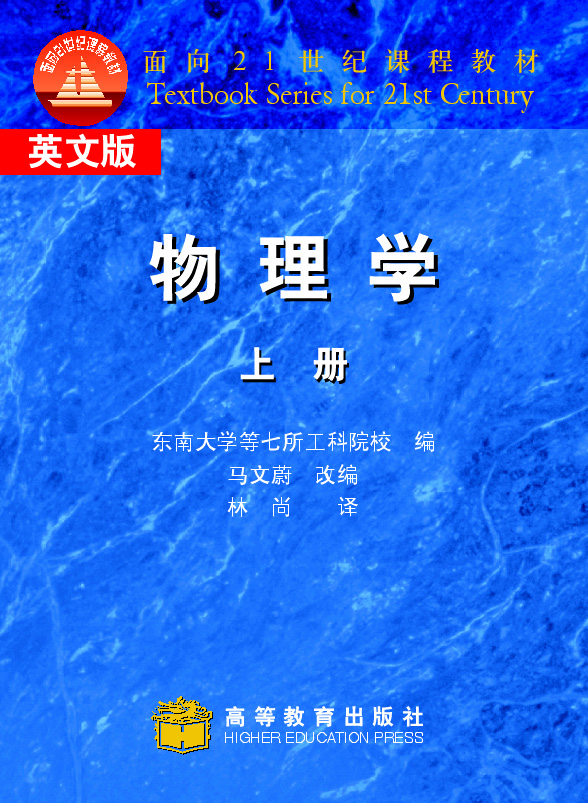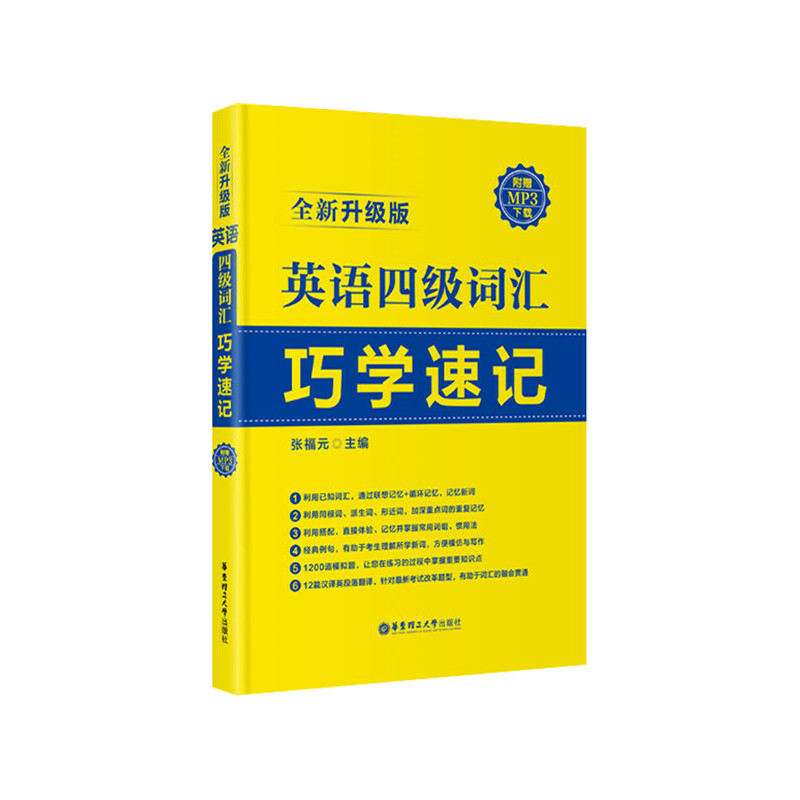物理学(第四版)(英文版)上册
作者: 林尚
出版时间:2004-11-23
出版社:高等教育出版社
- 高等教育出版社
- 9787040155754
- 1
- 248624
- 平装
- 16开
- 2004-11-23
- 490
- 406
本书是马文蔚等编著的《物理学》(上册)(第四版)的英文版本,由几位美籍华人物理学家翻译完成,克服了国内作者编写的英文教材使用“中国英语”的弱点,英文叙述十分纯正。本书的中文版在我国大学物理教学被广泛采用,具有非常大的影响,该书的英文版本将为我国的大学物理双语教学提供一本优秀教材。
本书可供普通高等学校工科各专业作为双语教学教材使用,也可供其他专业和社会读者参考。
Chapter 1 The Kinematics of Mass Points
1-1 The description of the movements of mass points
ference frames and mass points
sition vector,equation of motion and displ acement
locity
celeration
1-2 Motion of a mass point with constant acceleration
e equation of motion of amass point with constant acceleration
tion of a projectile
1-3 Circular motion
anar polar coordinate system
gular velocity of the circular motion
ngential and normal accel eration of circular motion,angular motion
rcular motion with uniform speed and circular motion with uniform acceleration
1-4 Relative motion
me and space
lative motion
Questions
Exercises
Chapter 2 Newton’s Laws
2-1 Newton’s laws
wton’s first law
wton’s second law
wton’s third law
2-2 Units and dimensions of physical quantities
2-3 Some forces often seen
e gravitational force
e elastic force
e frictional force
2-4 The inertial reference frame and the relativity principle of mechanics
e inertial reference frame
e relativity principle of mechanics
2-5 Examples of the applications of the Newton ’s laws
*2-6 Non-inertial reference frames and the inertial forces
Questions
Exercises
Chapter 3 The Laws of Momentum Conservation and Energy Conservation
3-1 The theorem of momentum of a particle and a system ofparticles
pulse and the theorem of momentum of a particle
e theorem of momentum of a system of particles
3-2 The law of momentum conservation
*3-3 The problem of mass transport within a system
3-4 The theorem of kinetic energy
rk
e theorem of kinetic energy of a mass point
3-5 Conservative force,non-conservative force and potential energy
e features of the work done by the gravitational force,the gravity,and the el astic force
e onservative force and the non-conservative force,the mathematical expression of the work done by the onservative force
tential energy
e potential energy curve
3-6 The principle of work and energy,the law of the conservation of mechanical energy
e theorem of kinetic energy of a system of particles
e principle of work and energy of a system of particles
e law of conservation of mechanical energy
e universal speeds
3-7 Complete elastic collision and complete inelastic collision
3-8 The law of energy conservation
*3-9 Center of mass and the law of motion of the center of mass
nter of mass
e law of motion of the center of mass
Questions
Exercises
Chapter 4 Rotations of Rigid Body
4-1 The rotation of a rigid body about a fixed axis
e angular velocity and the angular acceleration of a rotating rigid body
rmul a of uniformly accelerated rotation
e relations between angular quantities and linear quantities
4-2 Torque,the law of rotation,and the moment of inertia
rque
e law of rotation
ment of inertia
e theorem of parallel axes
4-3 Angular momentum and the law of angular momentum conservation
e angular momentum theorem of a mass point and the law of angular momentum conservation
e theorem of angular momentum and the law of conservation of angular momentum of a rigid body rotating about a fixed axis
4-4 Work done by a torque and the theorem of kinetic energy of a rigid body rotatingabout a fixed axis
rk done by a torque
e power of a torque
e kinetic energy of rotation
e theorem of kinetic energy of a rigid body rotating about a fixed axis
*4-5 The translation of a rigid body on a plane
4-6 The successes and limitations of classical mechanics
assical mechanics is only applicable for low speed motions,not for high speed motions
terminism and randomness
e continuity and quantization of energy
Questions
Exercises
Chapter 5 The Universal Gravitational Field
5-1 Kepler’s laws
5-2 The universal gravitational law
5-3 The gravitational field and the gravitational potential en ergy
e gravitational field
e intensity of the gravitational field
e gravita tional potential energy and the gravitational potential
e relation between the gravitational force and the gravitational potential energy
5-4 The gravitational potential energy and gravitational force between objects
e gravitational force between a uni form spherical shell and a mass point
e gravitational force between uni form spheres
e gravitational force and gravitational potential energy of a mass point inside anuni form sphere
e gravitational potential energy of a mass point near the surface of the Earth
5-5 The elliptic orbits of planets and the area law
everification of the elliptic orbit
e verification of the area law
Questions
Exercises
Chapter 6 Fundamentals of Thermodynamics
6-1 The state parameters of gases,the equilibrium state,and the state equations of the ideal gas
e stateparame tersof thegas
e units of p,V,andT
uilibrium state
e equation of the state of the ideal gas
6-2 Quasi-static processes,work,and heat
asi-static processes
rk
at
6-3 The internal energy and the first law of thermodynamics
e internal energy
e first law of the rmodynamics
6-4 The isochoric and isobaric processes of the ideal gas and the molar heat capacity
e isochoric process and the isochoric molar heat capacity
e isobaric process and the isobaric molar heat capacity
e specific heat
6-5 The isothermal process and adiabatic process of the ideal gas
e isothermal process
e adiabatic process
iabats and isotherms
*e polytropic process
6-6 The cyclic process and the Carnot cycle
e cyclic process
e heat engine and the refrigerator
e Carnot cycle
6-7 The expressions of the second law of thermodynamics and the Carnot theorem
e two expressions of thesecond law of the rmodynamics
e reversible process and irreversible process
e Carnot theorem
e quality of energy
6-8 Entropy and the principle of entropy increase
tropy
e calculation of the change of entropy
e principle of entropy increase
e principle of entropy increase and the second law of thermodynamics
Questions
Exercises
Chapter 7 Gas Kinetics
7-1 The microscopic model of matter and the statistical regular ity
e number density and scale of molecules
e molecular force
e disorder and the statistical regularity of the thermal motion of molecules
7-2 The pressure formula of the ideal gas
e microscopic model of the ideal gas
e pressure formula of the ideal gas
7-3 The relationship between the average translational kineti c ener-gy andtemperatureof the ideal gas
7-4 The equipartition theorem of energy and the internal energy of the ideal gas
grees of freedom
e equipartition theorem of energy
e internal energy and the molar heat capacity of the ideal gas
*e heat capacity of solids
7-5 The law of Maxwell speed distribution of gas molecules
e experiment of measuring the speed distr ibution of gas molecules
e Maxwell speed distribution law of gas molecules
e three statistical speeds
*7-6 The Boltzmann distribution law of energy and the isothermal gas pressure formula
e Boltzmann distribution law of energy
e isothermal gas pressure formula in the gravitational field
7-7 The average number of collisions of molecules and the meanfree path
7-8 The transport phenomena of gases
e viscous phenomenon
at conduction phenomenon
e diffusion phenomenon
e three transport coefficients
*7-9 The van der Waals equation of real gases
7-10 The statistical significance of the second law of thermodynamics
tropy and disorder
e degree of disorder and the number of microsc opicstates
tropy and the thermodynamic probability and the Boltzmann formula
*e phenomenon of self-organization
Questions
Exercises
Appendix 1 Vectors
Appendix 2 Some Fundamental Physical Constants
Appendix 3 The Legitimate Metric Units of China and the Inter-national(SI)Units
Appendix 4 Some Common Data of Air,Water,the Earth and the Solar System
Answers








